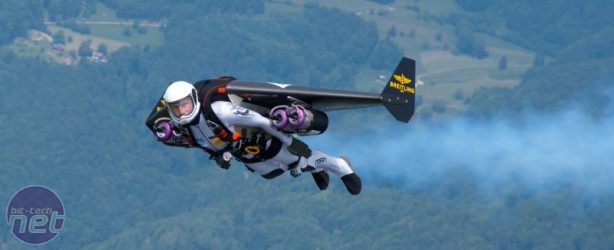Propulsion
If Batman needs to get around, he’s reliant on his rough and rugged batmobile, ‘the Tumbler’ and the Batpod cycle that spawns from its wreckage. Iron Man, however, has no need of vehicles – he can fly wherever he’s needed.Iron Man’s jet-propelled boots aren’t without real-world equivalents. In 2006 a particularly crazy Finn, Visa Parviainen, jumped from a hot air balloon in a custom wingsuit with two small turbojet engines strapped to his feet. With the engines fired, he managed thirty seconds of horizontal travel without losing any altitude.
Two years later, the Swiss Adventure Yves Rossy flew across the Channel in just ten minutes with a jet-propelled wing strapped to his back. Later the same year, he crossed the Alps, hitting speeds of 189mph along the way.
Parviainen hopped out of a balloon while Rossy leapt from a plane, but to take off and land from solid ground our real-life hero would need a rocket-belt or jetpack. Originally developed by the Nazis during World War II, the idea was continued by Bell Aerosystems in the 1960s, originally as a means of transporting US troops until the Army realised that, actually, a helicopter might be a little more practical and a bit less dangerous.
A Bell rocket-belt was flown in the Bond film, Goldfinger, while a JetPack International model was showcased in the opening ceremony of the 1984 Los Angeles Olympics. Two Brits, Stuart Ross and Richard Brown, are flying similar models today. Ross originally built his own jetpack but has now moved to a GoFast! Rocketbelt once flown by the jetpack height record holder, Eric Scott. Richard Brown, meanwhile, is perfecting his own, self-built jetpack, ready for an untethered flight in the near future.
The big problem with existing jetpacks is fuel; rocket fuel does not come cheap, and jetpacks can only carry enough for around 30 seconds of flight. Perhaps that’s why the most practical looking new jetpack, developed by the Martin Jetpack company of New Zealand, isn’t actually as much a jetpack as a personal helicopter, strapped to the user’s back and using twin rotors to achieve vertical take-off. The Martin Jetpack should fly for around 40 minutes on a tank of premium petrol, and the company is planning to sell it to leisure companies and private users later on this year. At around 70Kg it’s a bit heavier and bulkier than Iron Man’s jetboots, but it’s the closest thing we’re going to see for some time.
Falling with style
Batman has to do without flight as such, but in both Batman Begins and The Dark Knight, he makes some nifty use of his cape to glide. While this stretches reality, it’s not totally ridiculous. You could, for instance, recreate the memory cloth of the movies, which becomes rigid when an electric current is applied, with a material treated with the magnetorherological fluid we talked about earlier. Time to fly? Flick the switch, watch the cape take shape, and off you go.Would it glide? Well, in essence the cape works the same way as the wingsuits used by Visa Parvianen and the most lunatic thrill-seekers in the base-jumping community. Provided the cape provides enough lift as Batman flies forward, it should keep him airborne, the trick being to build up enough speed early on by letting gravity do its work. If you’re wondering, this is why he only uses the cape from a decent height in the movies.

MSI MPG Velox 100R Chassis Review
October 14 2021 | 15:04










Want to comment? Please log in.